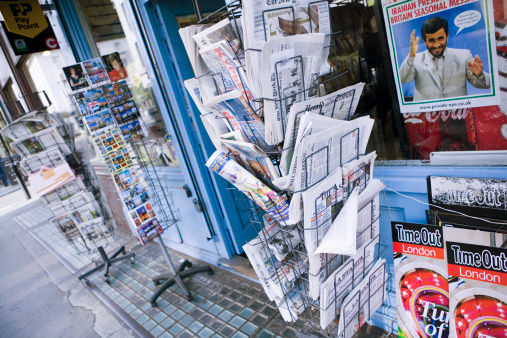The regional press still carries great importance. Wrongly maligned in some quarters, the stats almost speak for themselves.
The 1,000 local newspapers and 1,700 associated websites across the UK attract a whopping 97 million users every month. Studies show that regional news outlets are the most trusted and attract the most effective response to adverts too.
Yet let’s not beat around the bush, the regional press is also facing up to huge challenges.
The fall of classified advertising and the growth of online news – free and convenient to access – has resulted in a dangerous drop in revenues and a significant fall in the number of people reading print editions.

Big titles have seen the number of people paying for a copy halve in less than a decade. Large publishers such as Johnston Press no longer report their sales figures and many choose to focus on their total audience.
Those twin pressures have led to some pretty drastic action. If you’ve got an interest in journalism then feel free to depress yourself by reading the NUJ’s ‘roll call of newspaper closures and job losses’ to take a look at some of the more recent cuts. Thousands of people have left local newspapers and hundreds of titles now cease to exist.
The industry has achieved great reach online but, if we’re honest, no-one has definitively found a way to make enough money from this. That search continues.
So, what does this all mean for the world of marketing?
Well, only a fool would ignore the importance of the regional press. Unsurprisingly, people still want to know about the roads, schools, courts, shops and – above all else – people around them. The ‘content’ carries a big interest, the method of delivery is still in the process of evolving.
But there’s another thing that should be considered. The challenges outlined above and cost-cutting measures that these have sparked have drastically changed the way the regional press now looks.
By failing to keep up with the latest developments you risk misunderstanding the way papers now work and missing out on the chance to pitch your PR efforts in the right way.
So, what’s different?
Group editors
Let’s start at the top by looking at editors. It used to be the case that every title had its own editor, but this is no longer the case. Over recent years, groups of titles have been clustered together into regional groups. This has left group editors in charge of a long list of titles.
This has two meanings for people in PR.
Firstly, the editor for the title you are pitching to may well not be the person who runs the news operation there on a day-to-day basis. Secondly, with a long list of titles to manage, editors may well not be the people to contact or approach with pitches.

You might well get lost amid hundreds of emails in their swamped inbox. Equally, get in their good books and you might be able to get your content to run across a number of titles.
The emergence of group editors has been accompanied by new editorial structures that also need to be better understood.
In Johnston Press, this change has been known as the ‘newsroom of the future’. In simple terms this has meant that multiple titles have had their staff grouped into teams.
Instead of every reporter covering news in their own right, this model sees one team cover the entertainment, community and feature material for all of the titles in the group and another team looking at the news.
Again, this splitting of roles is significant when it comes to knowing who to contact. It has always been important to try to land on the right person at the right time when sending a press release and by understanding who you are contacting and their exact remit you can get this right.
In short then, each title might not have its own editor and each reporter may not work for a single title.
Photographers
Many regional newspapers no longer employ photographers. These roles have diminished significantly during the cuts of recent years.
Instead, they now rely on a mixture of freelance photographers – often the people they used to employ – images taken by reporters on smartphones and pictures submitted by members of the public.
Images are just as important as ever, however. Every web story needs an image to accompany it, after all, so there is still a big demand for pictures. For people in marketing, I think this makes it even more important to send a picture alongside a press release.
In the past, a staff photographer might have been sent out to cover something in a press release you’d send. Yet now, it’s unlikely that an editor would sanction freelance spending – which is saved for sporting events and major news stories – for anything you’ll send.
That might mean you need to source your own images or maybe even attend an event you’re promoting armed with a camera. Providing a quality image will help your pitch and is more important than ever.
Web deadlines
It used to be the case that regional papers were split into ‘weeklies’ and ‘dailies’. PR people could then get used to the deadlines surrounding these – either the time of the day or day of the week the title was ‘off stone’.

This information isn’t relevant for people in digital marketing. Pretty much every regional news outlet should now be seen as a daily operation online.
Every title will have its own targets for the number of stories it has to upload each day and will look to ensure it is pushing out fresh material in the morning, at lunch time and in the evenings.
In many ways, this helps people in PR. There is a constant demand to feed the 24/7 news cycle – even at relatively small titles – and to have things to push out to social channels.
Good, well-written content that can quickly be turned around and uploaded is worth its weight in gold. Provide it and you’ll earn yourself a good reputation with a journalist.
Video
Within those web targets, journalists will be expected to produce some form of video content.
One third of all online activity is spent watching video and the regional press, like everyone else, wants to capitalise on this by offering video to its readers.
Marketers should explore ways in which they can add video content to their PR pitches and need to be aware that the regional press might well appreciate this.
Receiving a nicely edited, interesting video could save a reporter an awful lot of time and effort – earning you plenty of brownie points and even more exposure for your brand.
Workload
Speaking of which, it’s important to remember that reporters working in the regional press probably have a lot on their plate.
Ex-Derby Telegraph and Leicester Mercury editor Keith Perch says some local newspapers have lost up to 80% of their staff in the last 10 years. He presented evidence on the state of the industry to the House of Lords and told the Press Gazette how one paper went from 140 journalists in 2006 to 36 in 2016. He said that his former paper, the Derby Telegraph, went from 120 to 32 journalists in the same period.
That means that journalists have had to be selective. These smaller teams will still have to produce a print edition and maintain web targets, and we’ve already seen that reporters now often have to double as photographers.
There’s no denying that this can result in a pressured environment and might mean fewer events can be covered in person.
From a marketing perspective, this means that it is important to present material that isn’t incomplete. By presenting a comprehensive package of quotes, pictures and maybe even video you’ll ease the journalist’s workload.
You might need to attend a client’s event yourself and provide material that ensures it receives coverage. If you’re prepared to put the effort in, it will bear fruit.
It’s important to present information that is as relevant as possible for the title in question. If you’ve got local stats or a particular angle that works for one specific title, flag this up as clearly as possible.
Don’t leave someone else to have to wade through a ton of data to find what they need. This, as I’ve written before, is one of the reasons why a journalist might well say no to you.
Sub editors – the wise figures in the newsroom that ensured quality control – have largely disappeared too, meaning it’s more important than ever to be ‘right first time’. If you can assist a reporter with this, by providing clean copy that needs little or no changes, you’ll prove popular.
Physical premises
Many newspaper offices have closed down in recent years. Some have simply moved to a smaller (and less expensive) location, often with no reception area to welcome members of the public. Meanwhile, others no longer have a physical building at all, with reporters now working from home or even libraries.
Again, it’s worth bearing this mind, especially if you’re trying to set up an interview between a contact and a reporter or even if you just want to get hold of a journalist.
Bear in mind too that many of these changes have only happened in the last couple of years and, as a result, the contact details on the paper’s site might well not be up to date.
Hyperlocals
One result of the changes in the regional press is that a number of fresh news outlets have sprung up.
Hyperlocal websites and papers have been set up across the country, often – as this example in Lincolnshire shows – by the people who have left jobs with traditional publishers as cuts have been made.
The fact that many of these are set up by trained and experienced journalists means that many have already been able to quickly establish themselves as trusted news outlets in their own right.
For people in marketing, this is another reason to update the old contacts book. These hyperlocals offer another PR opportunity and shouldn’t be overlooked.
A changing picture
There have, then, been a lot of changes in the regional press in recent years. By understanding these you’ll be better placed to get your material used by this important outlet.
Bear in mind too that the change is not yet finished – with interesting developments that may see a closer tie-up between the BBC and the regional press.
For now, here are seven lessons to take on board to help improve your relations with the local press:
- The regional press has changed in structure – many titles no longer have their own editor and many reporters no longer work for just one title
- There aren’t many staff photographers on the books any more so sending images is more important than ever
- The web means that every news outlet is effectively a daily operation
- Reporters are always on the lookout for good video, text and images – see if you can feed their need
- Job cuts have added to the workload for many journalists – this makes it important to present material that doesn’t have lots of loose ends to tie up
- Many papers have moved or closed offices – you might need to update your contacts book and bear this in mind
- Hyperlocals offer new PR opportunities.
source https://searchenginewatch.com/2016/11/28/off-page-pr-everything-you-need-to-know-about-changes-to-the-local-press/
No comments:
Post a Comment